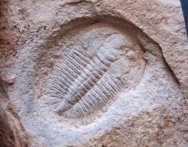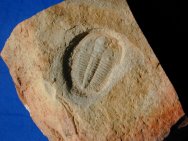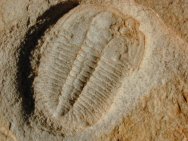Xystridura
st-smithi
Trilobite
Order Redlichiida, Suborder Redlichiina, Superfamily Paradoxidoidea,
Family: Xystriduridae, Subfamily: Xystridurinae
Geological
Time: Middle Cambrian
Size (25.4mm=1
inch): Plate size is 50 mm x 60 mm. Trilobite is 20 mm long
Fossil Site:
Beetle Creek Formation, May Downs Station, Mt Isa, Queensland, Australia
Code: Xystridura2
Price: Sold
 Description:
This is a nicely preserved specimen. It has retained the free cheeks,
which are normally not preserved. Some of the richest ore-bodies
in Australia occur in a great mass of severely deformed and altered
(metamorphosed) rocks at Mt Isa in north-west Queensland, One rock
unit, originally shale deposits, contains abundant fossil micro-organisms,
interpreted as blue-green algae. The trilobite beds date from the
Middle Cambrian, around 520 million years ago, and they rest directly
and unconformably on older metamorphic rocks such as those containing
the Mt Isa orebodies. Description:
This is a nicely preserved specimen. It has retained the free cheeks,
which are normally not preserved. Some of the richest ore-bodies
in Australia occur in a great mass of severely deformed and altered
(metamorphosed) rocks at Mt Isa in north-west Queensland, One rock
unit, originally shale deposits, contains abundant fossil micro-organisms,
interpreted as blue-green algae. The trilobite beds date from the
Middle Cambrian, around 520 million years ago, and they rest directly
and unconformably on older metamorphic rocks such as those containing
the Mt Isa orebodies.
|
|


